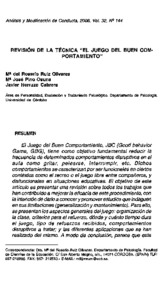Revisión de la técnica "el juego del buen comportamiento"
Autor
Ruiz Olivares, Rosario
Pino Osuna, M. José
Herruzo Cabrera, Javier
Editor
Universidad de HuelvaFecha
2006Materia
Juego del buen comportamientoModificación de conducta grupal
Intervención en el contexto escolar
Comportamientos disruptivos
Good behavior game
Modification of group behavior
School context intervention
Disruptive behavior
METS:
Mostrar el registro METSPREMIS:
Mostrar el registro PREMISMetadatos
Mostrar el registro completo del ítemResumen
El Juego del Buen Comportamiento, JBC (Good behavior
Game, GBG), tiene como objetivo fundamental reducir la
frecuencia de determinados comportamientos disruptivos en el
aula como gritar, pelearse, interrumpir, etc. Dichos
comportamientos se caracterizan por ser funcionales en ciertos
contextos como el recreo o el juego libre entre compañeros, y
disfuncionales en situaciones educativas. El objetivo de este
artículo es presentar una revisión sobre todos los trabajos que
han contribuido a mejorar la eficacia de este procedimiento, con
la intención de darlo a conocer y promover estudios que indaguen
en sus limitaciones (generalización y mantenimiento). Para ello,
se presentan los aspectos generales del juego: organización de
la clase, criterios para el refuerzo, dónde y cuánto tiempo dura
el juego, tipo de refuerzos recibidos, comportamientos
disruptivos a tratar; y las diferentes aplicaciones que se han
realizado del mismo. A modo de conclusión, parece que este procedimiento se presenta muy eficaz para reducir la frecuencia
de comportamientos disruptivos en contextos educativos The Good Behavior Game (GBG), has as main objective to
reduce the frequency of disruptive behavior in the class like:
shauting, fighting, in terrupting, etc. These behaviors are
characterized by being functional in certain contexts Iike the
playground or the free-game among partners and disfunctional
in instructiona/-academic settings. The main aim of this article
is to make a review about the published works that have
contributed to implement its efficacy, and to promote some pieces
of work that deals with their limits (generalization and
management). The general aspects of the game are presented,
class organization, support criteria where and how long the game
willlast, kind of support or reinforcements received, behavio'ur
disruptive to deal with and the different applications that the Good
Behavior Game. To conclude, it seems that this procedure is
presented very efficiently in order to reduce the frequency of
disruptive behaviour in educational contexts

